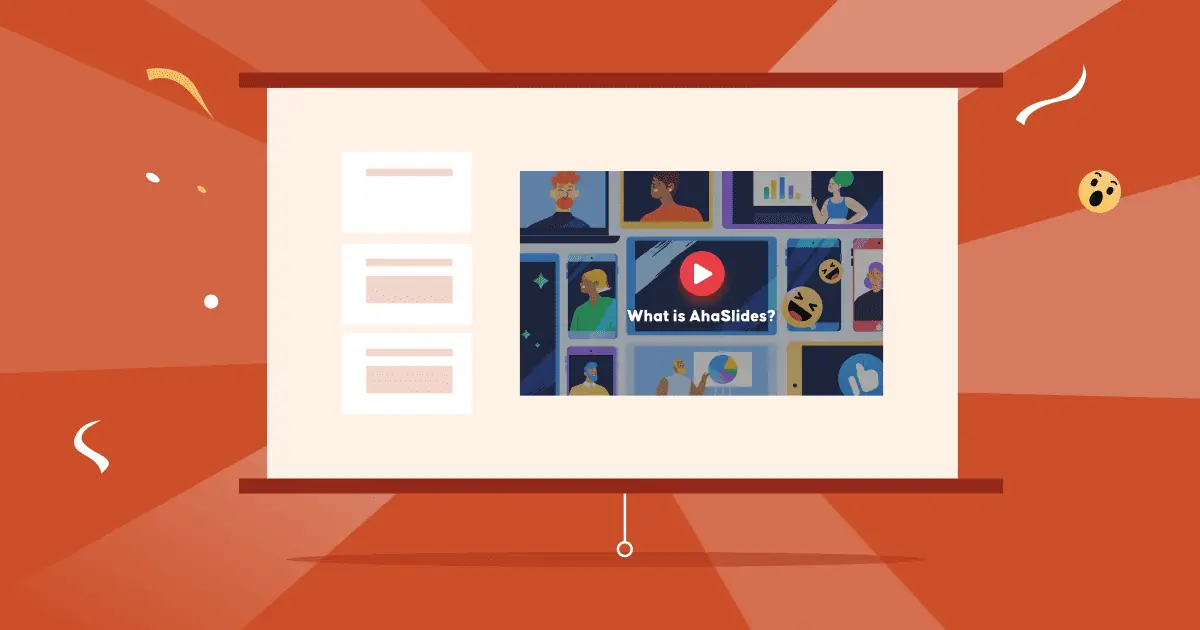初心者向けのディベート方法は? 議論というのは、本当に大きなテーマです。一度も経験したことがない人にとっては、何が起こるか、そして皆の前で全く理解できないと思われないようにするにはどうすればよいかを考えるだけで、途方に暮れてしまうかもしれません。
壇上に立つ勇気を奮い起こす前に、学ぶべきことはたくさんあります。でもご安心ください。この初心者向けディベートガイドでは、次のディベートで大活躍するために必要な手順、ヒント、そして例文をご紹介します。さあ、素敵なディベートのヒントをチェックしてみましょう!
目次
AhaSlidesのその他のヒント
初心者向けのディベートの仕組み(7ステップ)
プロのように議論を展開する方法を学ぶ前に、初心者向けのディベートの進め方について知っておく必要があります。初心者向けのディベートの7つのステップと、その過程で何をすべきかを確認すれば、より良いディベーターになる方法を完全に理解できるでしょう。
1.目的が決まっている

ディベートは、学校、会社の会議、パネルディスカッション、政治団体など、様々な場所や状況で活用できます。そのため、まずディベートの主な目的を明確にすることが重要です。これにより、ディベートの計画と構成が明確になります。なぜなら、後から調整しなければならない細かい点が多くあり、それらすべてが調和している必要があるからです。
まず、ファシリテーターがこれに答えます。 この討論の目標は何ですか?
たとえば、 学生討論目標は授業と同じであるべきです。例えば、生徒の批判的思考力や人前で話す能力を育むことなどが挙げられます。職場であれば、2つのアイデアのうちどちらを採用するかを決めることが目標になるかもしれません。
2.構造が選択されます
ディベートをうまく進めるには、構成が必要です。ディベートには様々な構成があり、その中には様々な形式があります。ディベートの準備をする前に、多くの一般的なディベートで使われる基本的な用語をいくつか知っておくことが重要です。
- ご用件 – すべての議論にはトピックがあり、正式には モーション or 分解能トピックは声明、政策、アイデアなど、議論の設定と目的に応じて異なります。
- ツー チーム – 肯定的な (モーションをサポート)と 負 (動きに反対)。 多くの場合、各チームはXNUMX人のメンバーで構成されています。
- 裁判官 or 裁定者:討論者の証拠とパフォーマンスで議論の質を判断する人々。
- タイムキーパー – 時間を記録し、時間切れになったらチームを止める人。
- オブザーバー – 討論にはオブザーバー(聴衆)が参加できますが、発言することはできません。
初心者の討論では、動議を受け取った後、チームは準備する時間があります。 The 肯定的な チームは最初の講演者から討論を開始し、続いて 負 チーム。 次に、のXNUMX番目のスピーカーに移動します 肯定的な チーム、XNUMX番目のスピーカーに戻ります 負 チームなど。
各講演者は、ディベートルールに記載されている設定時間内に話し合い、ポイントを発表します。 覚えておいてください を 討論はチームで終わります 負; 時々、チーム 肯定的な 終了するように求められます。
おそらく初心者なので、初心者向けの討論のプロセスをご覧ください。 以下わかりやすく、さまざまな種類の議論に活用できます。
3.ディベートプランが作成されます
議論をスムーズに進めるために、ファシリテーターは計画を立てます。 可能な限り詳細彼らはあなたにこの計画を知らせるべきです。そうすれば、すべてを視覚化して、あなたが軌道から外れないようにするのに役立ちます。これは、初心者向けのディベートに参加するときに非常に起こりやすいことです。
以下に、計画に含めるべき内容の簡単なチェックリストを示します。
- 討論の目的
- 構造
- 部屋の設定方法
- 各期間のタイムラインとタイミング
- 講演者と審査員に対する正式なディベートのルールと指示
- メモを取るテンプレート 役割のために
- それが終わったときに議論を閉じるための要約
4.部屋は配置されています
討論においては、環境が話し手のパフォーマンスにある程度影響を与えるため、環境は非常に重要です。
ディベートはできる限りプロフェッショナルな雰囲気で行われるべきです。ディベートルームの設営方法は様々ですが、どの設営方法を選ぶにせよ、ディベートの中心は中央の「スピーカーエリア」となります。まさにここで、ディベートの魔法が生まれるのです。
XNUMXつのチームを代表する各スピーカーは、順番にスピーカーエリアに立ち、終了すると席に戻ります。
以下である 人気のレイアウト例 初心者向けの討論:
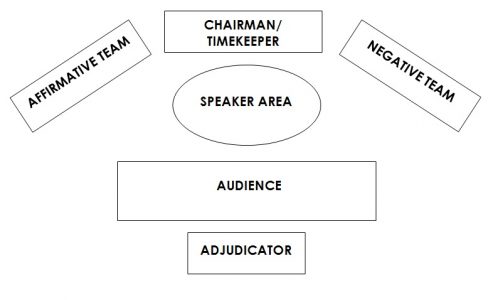
もちろん、オンラインでディベートを開催するという選択肢もあります。初心者向けのオンラインディベートでは、同じような雰囲気を味わうのは難しいかもしれませんが、盛り上げる方法がいくつかあります。
- 背景のカスタマイズ: ホスト、タイムキーパー、審査員、各チームなど、役割ごとにズームの背景が異なる場合があります。 これは、各参加者の役割を区別し、与えられた役割にいくらかの誇りを与えるのに役立ちます。
- サポートデバイス:
- タイマー: 討論では、特に初めての初心者にとって、タイミングは重要です。 ファシリテーターは、画面上のタイマーを使用してペースを追跡することを決定する場合があります(ただし、ほとんどの討論では、タイムキーパーは残り1分または30秒になると信号を送るだけです)。
- 音響効果: これは初心者向けの議論にすぎないことを忘れないでください。 ファシテーターが励まし、雰囲気を明るくしてくれると期待できます。 拍手効果音 話者が話を終えたとき。
5.チームが選ばれます
チームはに分けられます 肯定的な および 負。 通常、チームとそれらのチーム内のスピーカーの位置はランダム化されるため、ファシリテーターは スピナーホイール プロセスをよりスリリングで魅力的なものにするため。
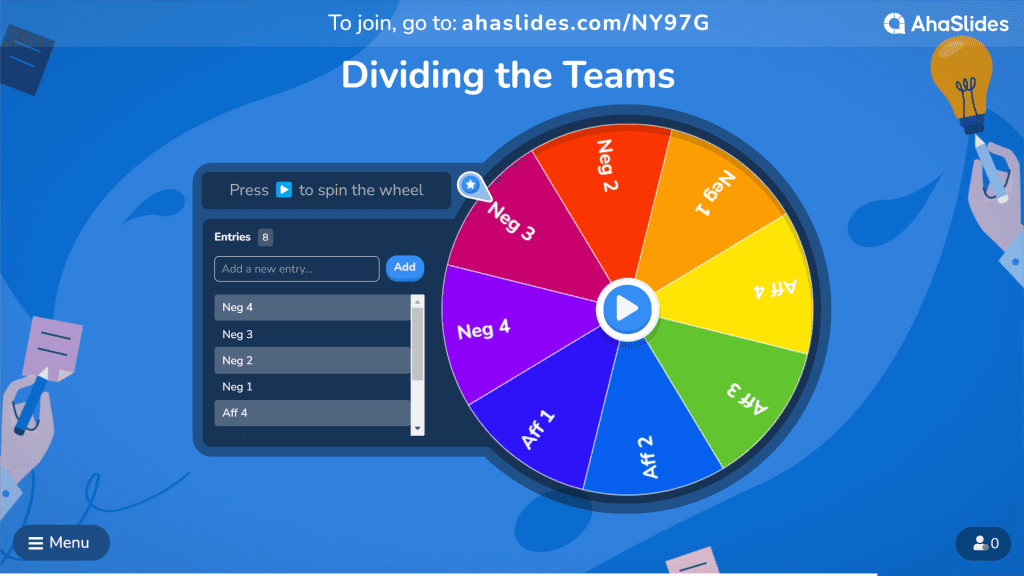
2 つのチームが選ばれた後、動議が発表され、準備のための時間が与えられます (理想的には 1 時間)。
今回は、ファシリテーターがさまざまなリソースを指摘するため、チームはコンテキストと問題を理解して、より強力なポイントを作成できます。 知れば知るほど、議論は活発になります。
6.討論が始まる
異なるタイプのディベートにはそれぞれ別の形式が必要であり、さまざまなバリエーションが存在します。 以下は、初心者向けのあらゆるディベートで使用できる非常に人気のあるバージョンです。
このディベートでは、各チームに6回の発言機会が与えられます。そのため、8人または6人の発言者が理想的です。XNUMX人の場合、XNUMX人のディベーターがXNUMX回発言します。
| スピーチ | 時間 | 討論者の責任 |
| 最初の肯定的な建設的 | 8分 | モーションとその視点を紹介します 重要な用語の定義を与える 運動を支持するために彼らの議論を提示する |
| 1番目のネガティブ建設 | 8分 | 動きに反対する彼らの議論を述べる |
| 2番目の肯定的な建設的 | 8分 | 動議とチームの意見を支持するさらなる議論をまとめる 紛争地域を特定する ネガティブスピーカーからの質問に答える(もしあれば) |
| 2番目の負の建設的 | 8分 | 動議に反対するさらなる議論を展開し、チームの意見を強化する 紛争地域を特定する 肯定的な講演者からの質問に答える(もしあれば) |
| 最初の否定的な反論 | 4分 | 守る 負 チームの主張を検証し、新たな主張や情報を加えずに支持する主張を打ち破る |
| 最初の肯定的な反論 | 4分 | 守る 肯定的な チームの主張を検証し、新たな主張や情報を加えずに反対の主張を打ち破る |
| 2番目の否定的な反論 (閉会の辞) | 4分 | XNUMX回目の反論と最終弁論を行う |
| 2回目の肯定的な反論 (閉会の辞) | 4分 | XNUMX回目の反論と最終弁論を行う |
💡 ルールによっては、反論の前に準備する時間が短い場合があります。
このフォーマットのビデオ例を見ることができます ここで.
7.討論を判断する
いよいよ審査員の出番です。審査員は各ディベーターのディベートとパフォーマンスを観察し、評価します。審査員があなたのパフォーマンスで注目するポイントは以下のとおりです…
- 組織と明確さ – あなたのスピーチの構成 – あなたがしたように展開することは意味がありますか?
- コンテンツ – あなたが作成する議論、証拠、反対尋問、反論。
- 配信とプレゼンテーションのスタイル – 口頭およびボディランゲージ、視線、口調など、自分の主張をどのように伝えるか。
新しい討論者のための10のヒント
最初からすべてをマスターできる人はいません。人生で一度もディベートをしたことがない人にとって、始めるのは容易ではありません。以下に挙げる内容についてご紹介します。 10の簡単なヒント 効果的に議論する方法を発見し、あらゆる議論で初心者に同調できるようにする。
#1 - 準備が鍵です – トピックを調査する たくさん 事前に背景情報だけでなく、自信も得ることができます。 これは、初心者のディベーターが問題をよりよく理解し、優れた反論のスターターとなり、議論の草案を作成し、証拠を見つけ、ウサギの穴に落ちることを避けるのに役立ちます。 すべてのディベーターは、アイデアをよりよく整理し、スピーチの「全体像」を把握するために、すべてをポイントで概説する必要があります (3 つの議論に対して 3 つのポイントが理想的です)。
#2 - すべてをトピックに保つ – ディベートにおける最大の欠点の一つは、議論の論点から逸れることです。貴重な発言時間を無駄にし、議論の説得力を失わせてしまうからです。アウトラインと要点に注意を払い、それらがトピックに沿っていて、適切な問題に取り組んでいるかを確認しましょう。
#3 - 例を挙げてポイントを作る – 例を挙げることで議論の文章がより説得力を持ち、また、人々は物事をより明確に理解できるようになります。 この 以下に例を示します。
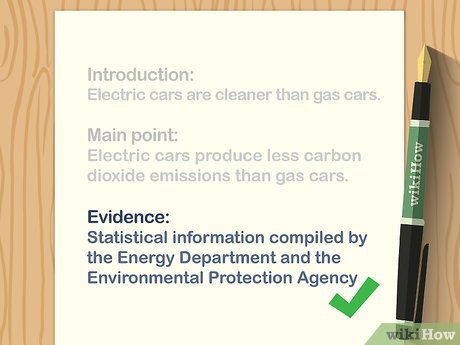
#4 - 対戦相手のように考えてみてください – アイデアを修正する際には、反対者が提起する可能性のある論点を考えてみましょう。いくつか挙げて、もし彼らが反論した場合に提示できる反論をマインドマップに書き出してみましょう。 do それらのポイントを作ることになります。
#5 - 強い結論を出す – 議論を数行の優れた文章で締めくくり、少なくとも要点をまとめましょう。多くの場合、討論者は力強く締めくくり、詩的に構成された一文で議論を締めくくり、聴衆を魅了します。 マイクドロップ 一瞬 (以下の例を確認してください).
#6 - 自信を持ってください(またはあなたがそれを作るまでそれを偽造してください!) ディベートで上達するために最も重要なことの一つは、雰囲気です。ディベーターは自分の発言に自信を持つ必要があります。自信は審査員や傍聴者に大きな影響を与えるからです。もちろん、準備をすればするほど、自信は深まります。
#7 - ゆっくり話す 初心者のディベーターによくある問題は、話すスピードです。最初のうちは、話すスピードが速すぎることがほとんどで、聞き手と話す人の両方に不安を与えてしまいます。息を吸ってゆっくり話しましょう。話せる内容は少なくなるかもしれませんが、そこから生まれる言葉には重みが生まれます。
#8 - あなたの体と顔を使う ボディランゲージは、自分の主張を裏付け、自信を示すのに役立ちます。相手の目を見て、良い姿勢を保ち、表情をコントロールし(攻撃的になりすぎないように)、注目を集めましょう。
#9 - 注意深く耳を傾け、メモを取る – ディベーターは、ペースについていき、チームメイトをサポートし、相手に効果的に反論するために、すべての発言とアイデアに注意を払う必要があります。反論や展開に必要なすべてのポイントを覚えておくことは不可能なので、メモを取ることは非常に役立ちます。重要なポイントだけを書き留めるようにしてください。
#10 - 安いショットは避けてください – 相手自身ではなく、相手の主張に焦点を当てて反論しましょう。ディベーターは他人を攻撃するような言動をしてはいけません。それはプロ意識の欠如を示し、間違いなく減点の対象となります。
初心者向けディベートの6つのスタイル
ディベートには、さまざまな形式やルールを持つさまざまなスタイルがあります。 それらのいくつかを徹底的に知ることで、初心者のディベーターがプロセスと何をする必要があるかを理解するのに役立ちます。 初めてのディベートでよく見られる一般的なディベート スタイルをいくつか紹介します。
1. ポリシーディベート これはよくあるタイプの議論で、多くの調査が必要です。議論は特定の政策を実施するかどうかを中心に展開され、通常は2人以上のチームで行われます。 ポリシーディベート 実用的で、他のタイプよりもルールがわかりやすいため、多くの学校で使用されています。
2. 議会での議論 このディベートスタイルは、英国政府のモデルと英国議会における議論に基づいています。英国の大学で最初に採用され、現在では世界大学ディベート選手権や欧州大学ディベート選手権といった多くの大規模なディベート大会の公式ディベートスタイルとなっています。このディベートは、従来のディベートよりも機知に富み、短いものとなっています。 方針 中学生から大学まで、多くの場合に適した議論になります。
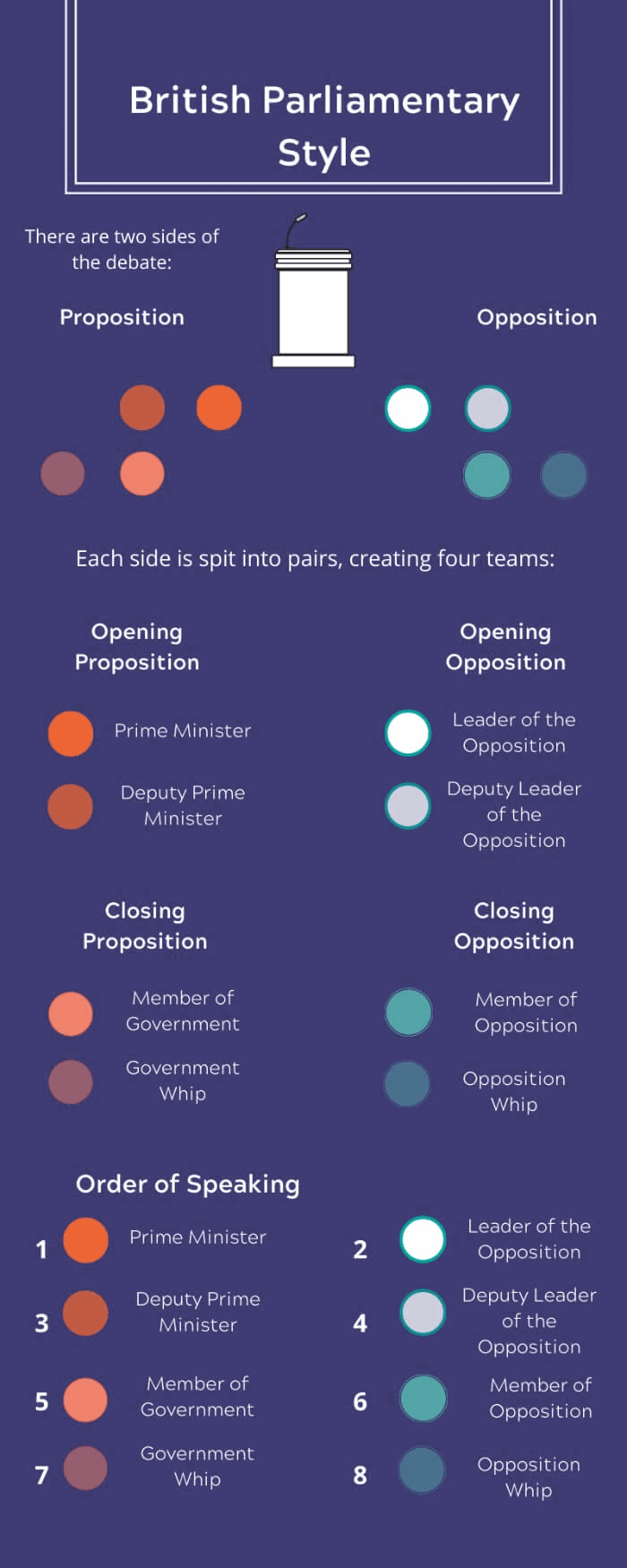
3. 公開フォーラムの討論 – この形式では、2つのチームが「ホット」で物議を醸している話題や時事問題について議論します。これらの話題は、おそらくすでに意見を持っているものなので、このタイプの議論は、 方針 ディベート。
4. リンカーンダグラス 議論これは、1858年にアメリカ上院議員候補のエイブラハム・リンカーンとスティーブン・ダグラスの間で行われた有名な一連の討論にちなんで名付けられた、オープンなXNUMX対XNUMXの討論形式です。この形式では、討論者は主に重要な問題について、より深遠で哲学的な質問に焦点を当てます。
5. 自発 議論 2人のディベーターが特定のトピックについて議論します。非常に短い時間で議論を組み立て、事前の準備もほとんどせずに相手の意見に素早く反論する必要があります。これは高度な議論スキルを必要とし、自信を高め、舞台恐怖症を克服するのに役立ちます。
6. 議会の 議論 – この形式は米国議会のシミュレーションであり、討論者は議員を模倣します。法案(提案法)や決議(意見表明)など、様々な立法事項について討論します。その後、模擬議会は法案の可決投票を行い、その後も法案の賛否を問う投票を行います。
2ディベートの例
ここでは、議論がどのように行われるかがよくわかるように、いくつかの議論の例を 2 つ挙げます。
1.英国議会の討論
これは、英国の元首相テリーザ・メイ氏と元労働党党首ジェレミー・コービン氏による討論の短い動画です。この討論のダイナミックな雰囲気と白熱した議論は、この種の騒々しい討論によくある光景です。メイ氏は最後に力強い言葉で締めくくり、その動画は拡散されました。
2.討論者
学生の討論 学校ではディベートがますます人気を集めています。上手に演じられたディベートは、大人のディベートに匹敵するほど魅力的なものになることもあります。この動画は、ベトナムの英語ディベート番組「The Debaters」のエピソードです。高校生たちが「グレタ・トゥーンベリに拍手」という議題について、よくある3対3の形式でディベートを行いました。






